Put pep in your meals with its gluten-free soba noodles, quick to prepare. They are lighter in the stomach, but satiating, and full of flavor. Perfect for plant-based or special diets, they will make you feel like the queen of gluten-free vegan cuisine.
Try them out and add diversity to your table effortlessly!
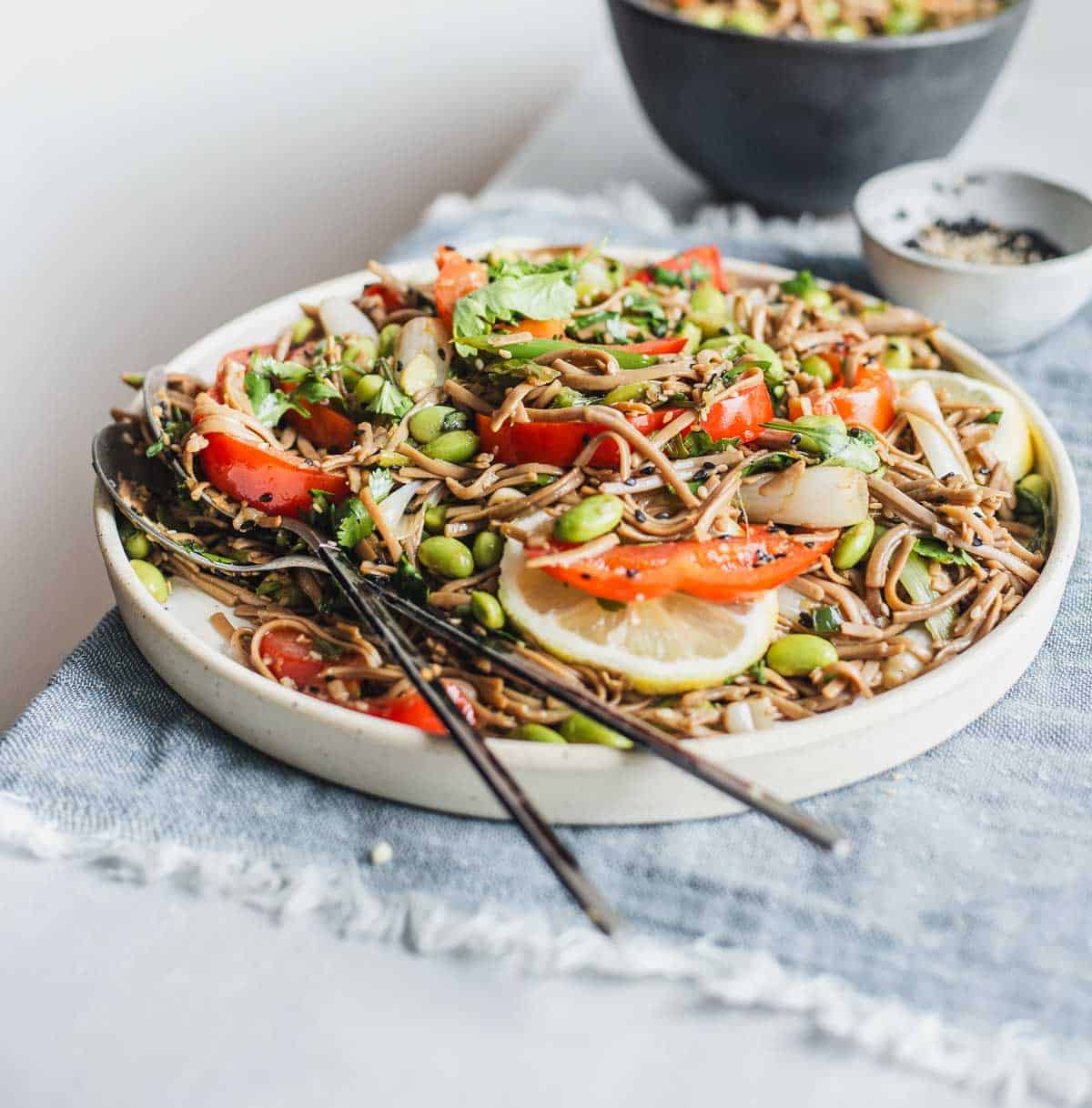
Watch How it's Done
Jump to:
Why This Recipe Rocks
It started with a small mistake by my partner: a pack of soba noodles instead of bean noodles. Not enough to break three legs to a duck, but it tickled my curiosity. It was like a click, an invitation to explore new culinary horizons.
And what a delight when I immersed myself in Plenty More by Yotam Ottolenghi.
I know how you feel: too much stuff to do, not enough time, and this insatiable urge to feed your family healthy, nutritious, but also gourmet dishes. That's where this noodle dish comes in.
A simple and tasty solution to a daily problem.
These soba noodles contain a lot of health benefits, and this recipe is packed with protein. Did I tell you that they cook faster than traditional pasta (half the time)?
This dish is an explosion of sensations in every bite: the crunch of vegetables, the subtle aroma of soba noodles, all enhanced by a hint of soy sauce. A balanced blend, like a symphony of flavors playing in harmony. The pleasure is as much in the preparation as in the tasting. A delicious dance that starts in the kitchen and ends at the table.
These Japanese noodles can be served with a fresh salad, or be the main course of a dinner with friends. And the best part?
That moment of pure joy when you see the illuminated faces of your family, rejoicing with every bite. The flavors, the textures... It is endless happiness.
By the way, can you hear me in the distance noisily sucking up those noodles? This is proof of my glowing appreciation.
What Goes in It?

Ingredients Notes
- Soba noodles. Soba noodles, aka buckwheat noodles, are typically made from buckwheat flour, giving them a brown color and a distinct nutty flavor. They are usually composed of 80% buckwheat with 20% wheat flour. Search for gluten-free soba noodles in the international produce aisle of your supermarket or online. I like the organic King Soba Organic brand because their noodles contain 100% buckwheat. (They can be made from scratch with organic buckwheat flour, arrowroot starch or tapioca starch and water.)
- Garlic and ginger. These two Asian food superstars add an incredible depth of flavor. The fresher, the better. But you can also use potted versions to save time.
- Chili pepper. I opted for fresh green chili, but crushed chili or cayenne pepper will go too.
- Edamame. These small soybeans are a good source of protein and fiber. You can find them frozen in most supermarkets.
- Mirin. It is a sweet rice wine, pale yellowish to amber, syrupy, and quite sweet, with an alcoholic degree generally lower than sake. White or brown rice vinegar also work.
- Lemon. I prefer yellow lemon for this recipe. I've used lime before, but I found the noodles a bit bitter. It could be different for you, so don't deprive yourself of it.
Get Your Free Plant-Based Eating Toolkit and More
Subscribe to my newsletter and unlock my plant-based course, nutrition charts, recipe secrets, and exclusive updates to prepare wholesome, varied & balanced meals effortlessly. All you need is a good appetite. Subscribe!
How to Make These Gluten-Free Soba Noodles in 4 Steps
Before jumping into the thick of the action, I start by bringing a large pot of water to a boil and while it's heating, I prepare most of the ingredients: I chop the green onions and crush the garlic; I peel and grate the ginger; I blanch the frozen edamame, cool it and let it dry; I chisel the cilantro; I zest and cut the lemon into wedges. Basically, I do the set-up.
Once the water is wriggling, I cook the soba noodles as directed on the package (about 5 minutes), until they are al dente, supple and stretchy. Afterwards, I drain them, rinse them well with warm water and reserve them in a bowl with a little sunflower oil that I stir in ①. I cover the bowl and set it aside.
Then I heat sunflower oil in a wok or frying pan over high heat. I add the green onions, garlic, ginger, and chilies, and stir fry for 3 minutes; the soybeans follow ②.
I check the noodles to make sure they haven't stuck together (if they do, I quickly rinse them under warm water, drain them, and put them back in the bowl). I pour the contents of the wok over it, followed by seasonings (sesame oil and seeds, tamari, mirin, coriander, and salt) ③. I stir everything and sprinkle with lemon zest ④.
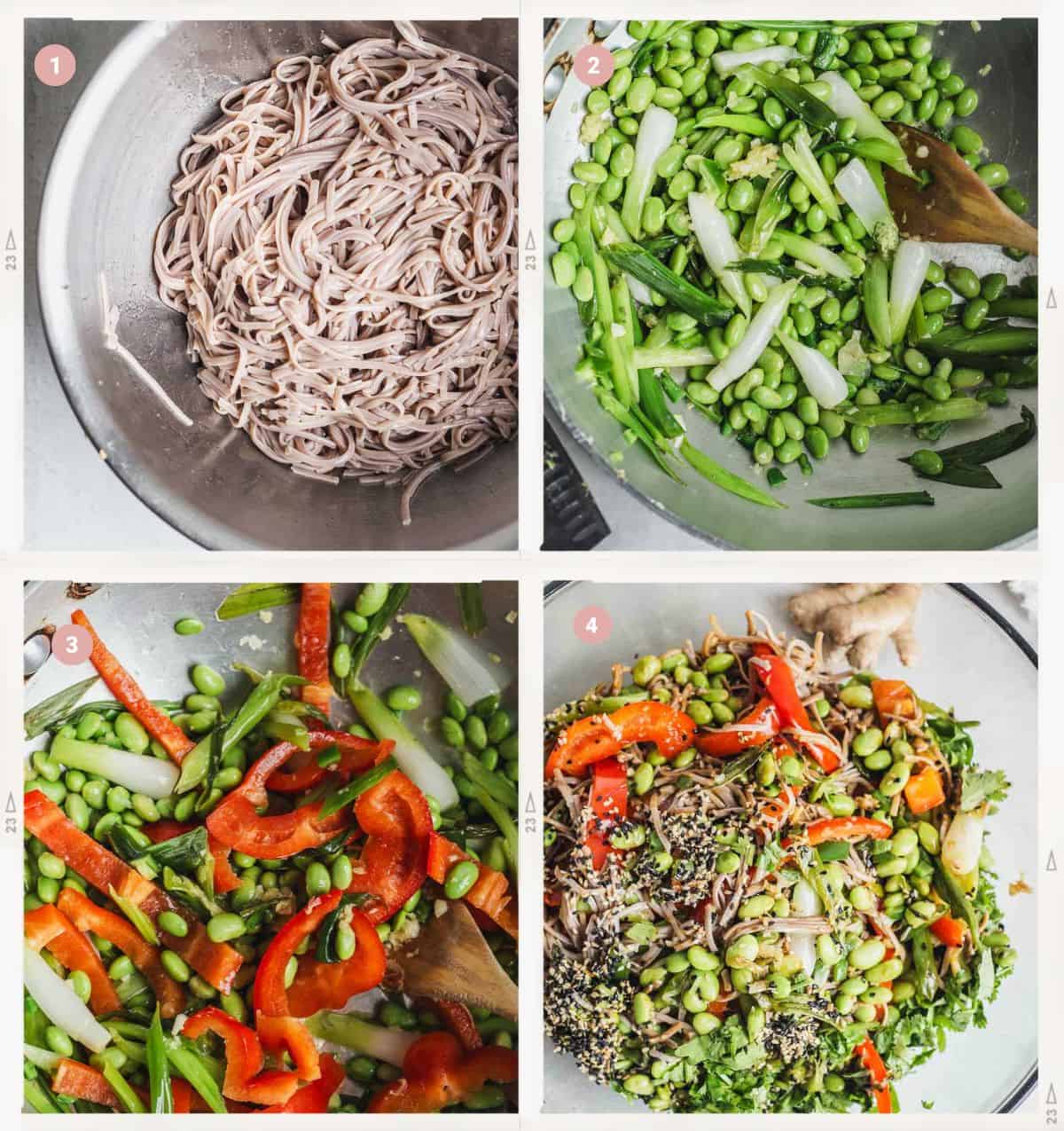
I arrange the noodles in serving bowls and serve them with the lemon wedges in a small bowl next to it, plus the chopsticks.
Essential equipment
To prepare this recipe, you will need:
- A large saucepan to cook the noodles.
- A cutting board.
- A sharp kitchen knife.
- A drainer to drain the noodles.
- A large pan, frying pan or wok to sauté the ingredients.
- A wooden spoon.
- A large bowl or pothole to mix noodles and cooked ingredients.
- A small bowl to put the lemon wedges.
- Serving bowls and chopsticks to taste the noodles.
The Keys to Success: My Top Tips
Be attentive and defensive. Soba noodles require unfailing attention, like a child unveiling his latest masterpiece. Multitasking prohibited. First, you must handle them carefully, as they tend to be brittle, and second, you must watch its cooking for the reasons below.
Make a distinguished dive. Cook the soba noodles in a saucepan worthy of their stature (size); they deserve this royal bath.
Avoids mass en masse. Don't overload your pan by cooking too many noodles at once. This could make the noodles stick together.
May the soba be serene. Be sure to rinse your soba noodles TWO TO THREE TIMES in cold water after cooking. This is the most important step of all. After pouring the noodles into a colander, transfer them to a bowl of cold water and swirl. Or simply rinse them under running water. Keep them moving in or under water for about a minute to remove excess starch that creates a gummy texture. This stops the cooking process and makes them less sticky.
It's purer when it's natural. Does not add salt to the water. The noodles will remain plain until they meet their sauce or broth.
Serve it all in speed for noodles in finesse. Quickly serve the noodles after cooking, their delicate, ephemeral flavor evaporates instantly.
Simple Substitutions and Add-Ins
- Change noodles. Have brown rice noodles, glass noodles, udon noodles, or other gluten-free noodles. And if you don't have gluten intolerance, opt for 80% buckwheat noodles with 20% wheat flour.
- Stir in fine herbs. You can replace green onions with chives or parsley.
- Play with intensity. Red chili pepper can be replaced with chili flakes or remove it if you prefer a non-spicy version.
- Boost your protein intake. You can also add tofu or tempeh.
- Brings more diversity. Add grilled vegetables, such as red bell pepper.
- Mineralize your noodles. You can sprinkle it with seaweed on top like wakame for more minerals.
The Special Diets Corner
If you have food intolerances, besides gluten intolerance, here are some ideas to make this dish ...
- Low-FODMAP vegan. Use green-stemmed green onions only and remove garlic and use my garlic-infused olive oil.
- Low-fat. You can use water to sauté garlic, ginger, and chili pepper instead of oil.
Answers To Your Burning Questions (FAQ)
Buckwheat is a flowering plant belonging to the Polygonaceae family, just like rhubarb and sorrel. It is often classified as a cereal because of its use in cooking, but it is not part of the grass family like wheat or rice. In other words, it is not a type of wheat.
Buckwheat seeds, also called grebiche or kacha in some cultures, are used to produce flour and noodles (like Japanese soba), or can be eaten whole, roasted or boiled.
Buckwheat is especially valued for its high protein content — it has various types of essential amino acids, such as lysine and arginine — fiber and minerals, and for the fact that it does not contain gluten, making it a great option for people with celiac disease or gluten sensitivity. In addition, it is a low glycemic index food, making it a good option for people with diabetes and high blood pressure and heart disease.
Yes, you can cook them in advance, rinse them under cold running water, and then quickly warm them up in the pan before serving.
Yes, you can use other types of noodles, but the taste and texture will be different.
Troubleshooting
If your soba noodles stick together, be sure to rinse them well with cold water after cooking.
If the dish is too spicy, add a little sugar or honey to balance the heat
How to Store it
You can store cooked soba noodles in the refrigerator for 3 to 5 days. You can enjoy cold or heated soba noodles in a pan with a little oil.
What to Serve this Gluten-Free Soba Noodles with
Traditionally, soba is served chilled with a dip or in hot broth like noodle soup. Certainly, they marry perfectly with the following accompaniments:
- Miso soup. Thanks to its umami flavor, light texture, protein richness, and temperature contrast, it perfectly complements soba noodles, thus respecting the Japanese culinary tradition.
- Fresh salad. This can be a simple spring salad or Wakame seaweed. The latter is often used in Japanese cuisine.
- Vegetable tempura. The crispy vegetables coated in a light dough and then fried add a pleasant texture and delicious taste that goes well with soba noodles.
- Japanese-style coleslaw. A mixture of napa cabbage, carrots, and sesame seeds with rice vinegar-based dressing provides a tangy flavor that balances soba noodles.
- Marinated and grilled tofu. Tofu is an excellent source of protein for people of plant descent. When marinated in soy sauce, garlic, and ginger and then grilled, it adds a depth of flavor to soba noodles.
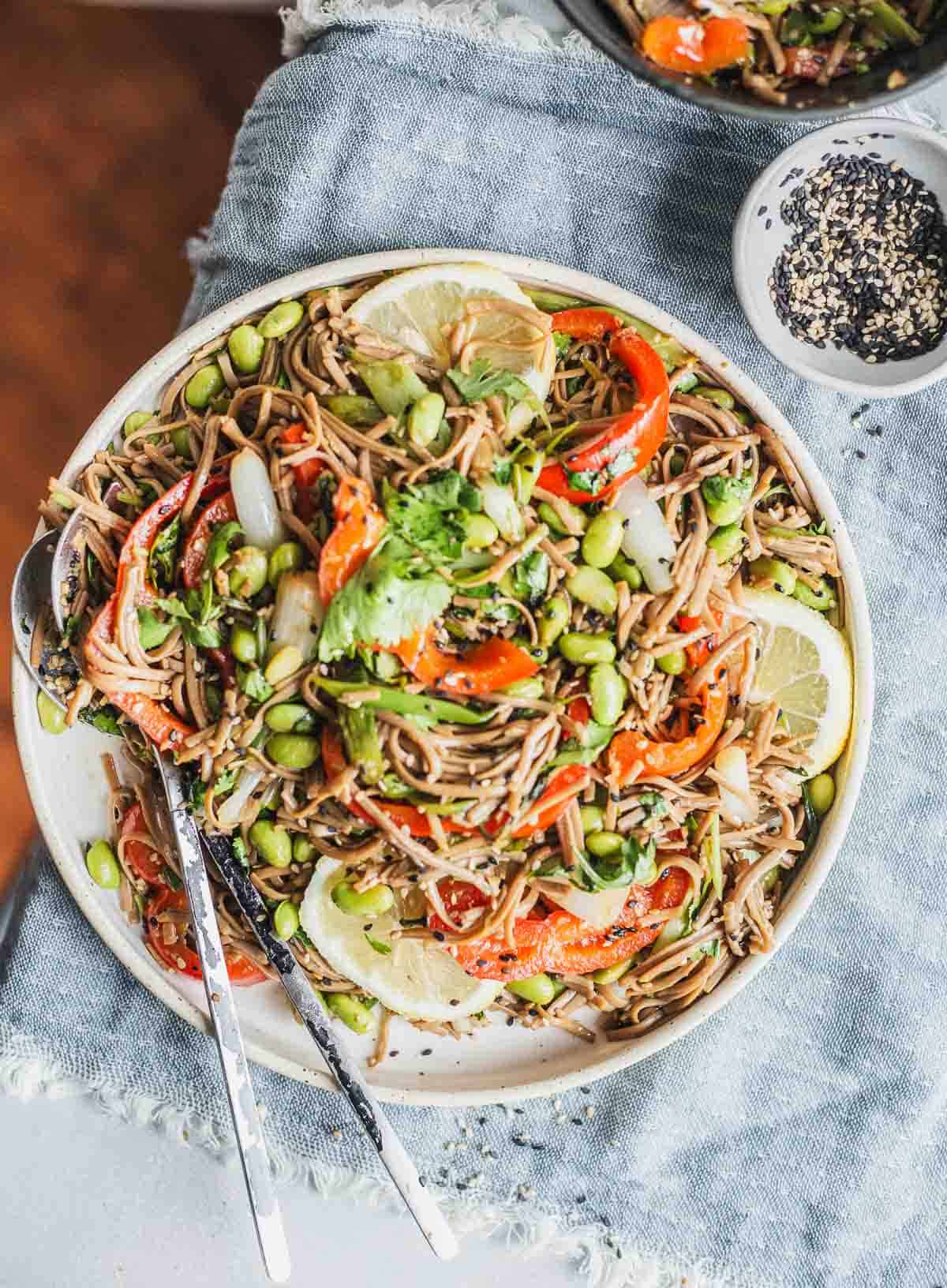
More Pasta Recipes
Make These Gluten-free Noodles Now
Here you are in your kitchen, facing your pack of gluten-free soba noodles with this little voice that tells you: "I don't have time, I'm not a chef". You know her, don't you? But remember, you are an everyday hero, always ready to offer healthy meals to your family. And these soba noodles, they are your answer: a quick, healthy, delicious dish.
Imagine the satisfied smiles of your family in front of this tasty and nourishing meal after making this vegan, gluten-free, tasty, easy to prepare dish.
So, what are you waiting for? Whether you follow a gluten-free diet or not, go for it, let your creativity speak for itself in the kitchen, and savor the difference a homemade meal can make.
Remember: happiness is in soba.
If you try this recipe, I want to know about it! I always appreciate your feedback. Leave a star rating in the recipe card right below and/or a review in the comment section further down the page. You can also follow me on Pinterest, Facebook, or Instagram. Sign up for my email list, too!
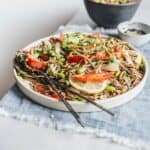
Gluten-Free Soba Noodles Recipe
Ingredients
- 1 package dried soba/buckwheat noodles (about 250 g) (Notes)
- 2½ tablespoon sunflower oil or olive oil
- ½ lb green onions white and green parts, trimmed and cut to the diagonal into 1 ¼-inch long (about 225 g/2 cups or 16-18)
- 1 teaspoon crushed garlic 1 clove
- 2- inch fresh ginger peeled and grated
- 2 chiles or ¼ teaspoon Cayenne pepper
- 1 ⅔ cup frozen shelled edamame blanched for 3 minutes, cooled and left to dry (about 250 g)
- 1 tablespoon sesame oil
- 3 tablespoons black and white sesame seeds (roasted or not)
- ¼ cup tamari soy sauce or shoyu sauce
- 2 tablespoons mirin
- 1 cup cilantro coarsely chopped
- 1 lemon zested and then cut into slices
- Salt to taste
Instructions
- Bring a large pot of water to a boil and cook the noodles as instructed on the package (about 5 minutes), until al dente. Drain well, rinse under lukewarm water, and set aside in a large bowl with 1 ½ teaspoon of sunflower in a warm place until later use.
- Heat the remaining 2 tablespoons of sunflower oil in a large wok or frying pan over high heat. Add the green onions, garlic, ginger and chili peppers and cook, 2 to 3 minutes over high heat, stirring frequently, until the onions soften a little, without becoming too soft. Add the edamame and heat for about 30 seconds.
- Quickly rinse the noodles under warm water if glued together and then, once drained, pour the contents of the wok over them, followed by sesame oil, sesame seeds, tamari, vinegar, cilantro and ⅓ teaspoon of salt. Mix well, sprinkle the lemon zest on top and serve immediately, with the slices next to it.
- Placed in an airtight container, these soba noodles will keep in the refrigerator for 3 to 5 days.
Notes
- Handle the soba noodles carefully as they tend to be brittle. Don't overload your pot by cooking too many noodles at once. This could make the noodles stick together.
- Be sure to rinse your soba noodles TWO TO THREE TIMES in cold water after cooking. This is the most important step of all. After pouring the noodles into a colander, transfer them to a bowl of cold water and swirl. Or simply rinse them under running water. Keep them moving in or under water for about a minute to remove excess starch that creates a gummy texture. This stops the cooking process and makes them less sticky.
- Do not add salt to the water. The noodles will remain plain until they meet their sauce or broth.
- Quickly serve the noodles after cooking, their delicate, ephemeral flavor evaporates instantly.
Variations
- Change the soba noodles with brown rice noodles, glass noodles, udon noodles, or other gluten-free noodles. And if you don't have gluten intolerance, opt for 80% buckwheat noodles with 20% wheat flour.
- Replace the green onions with chives or parsley.
- Red chili pepper can be replaced with chili flakes or remove it if you prefer a non-spicy version.
- Add tofu or tempeh.
- Put grilled vegetables, such as red bell pepper.
- Sprinkle it with seaweed on top like wakame for more minerals.
- Swap the mirin for 2 tablespoons lemon juice and 1 teaspoon maple syrup or white or brown rice vinegar.
Nutrition
Get Your Free Plant-Based Eating Toolkit and More
Subscribe to my newsletter and unlock my plant-based course, nutrition charts, recipe secrets, and exclusive updates to prepare wholesome, varied & balanced meals effortlessly. All you need is a good appetite. Subscribe!


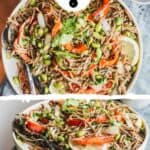
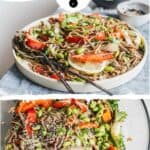
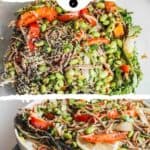
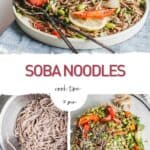
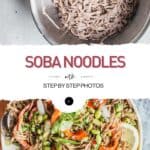
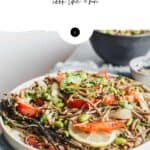
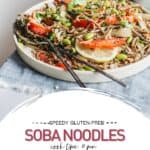
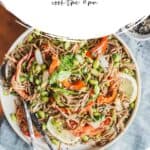

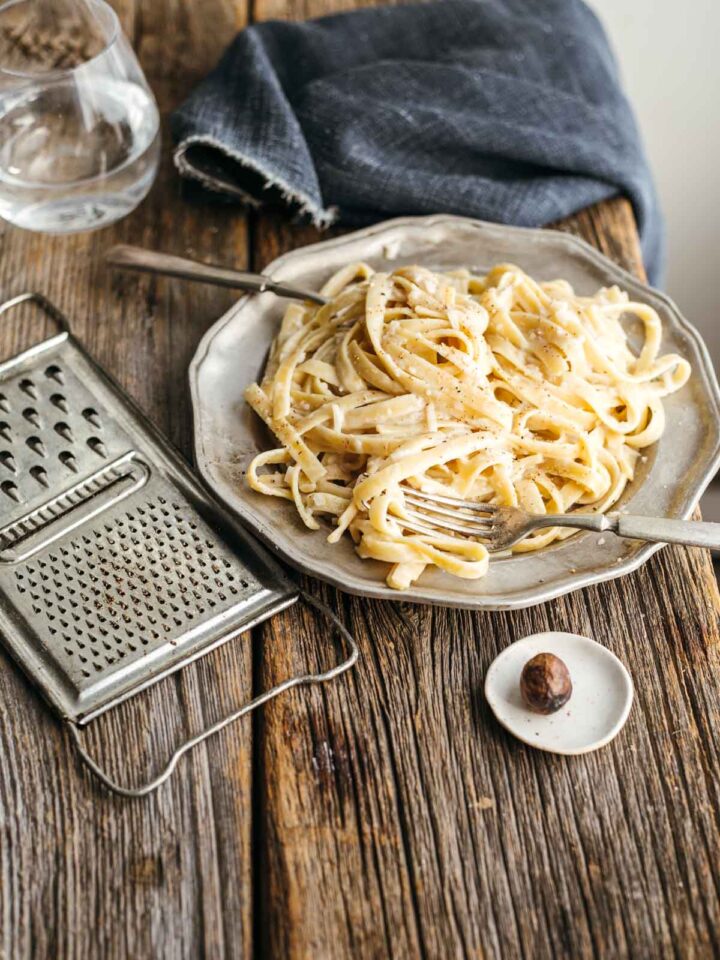
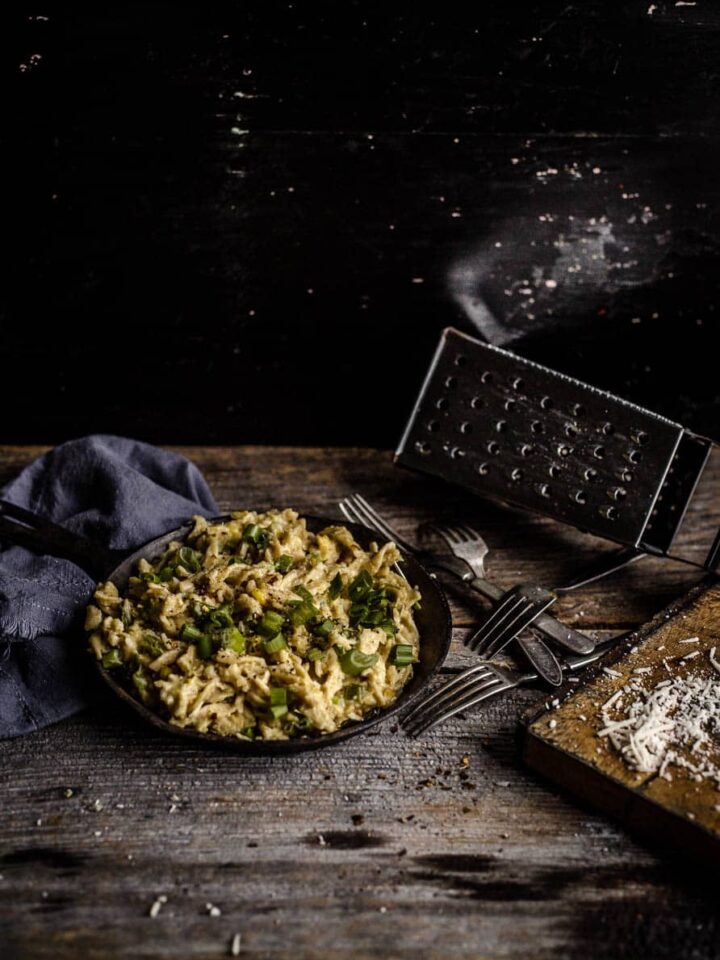
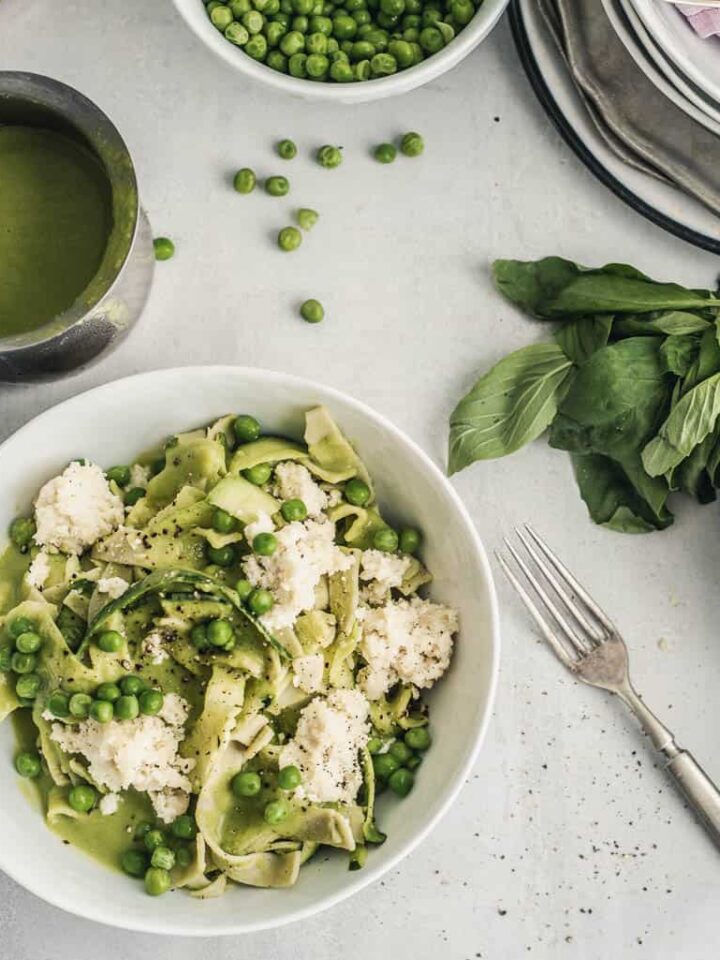

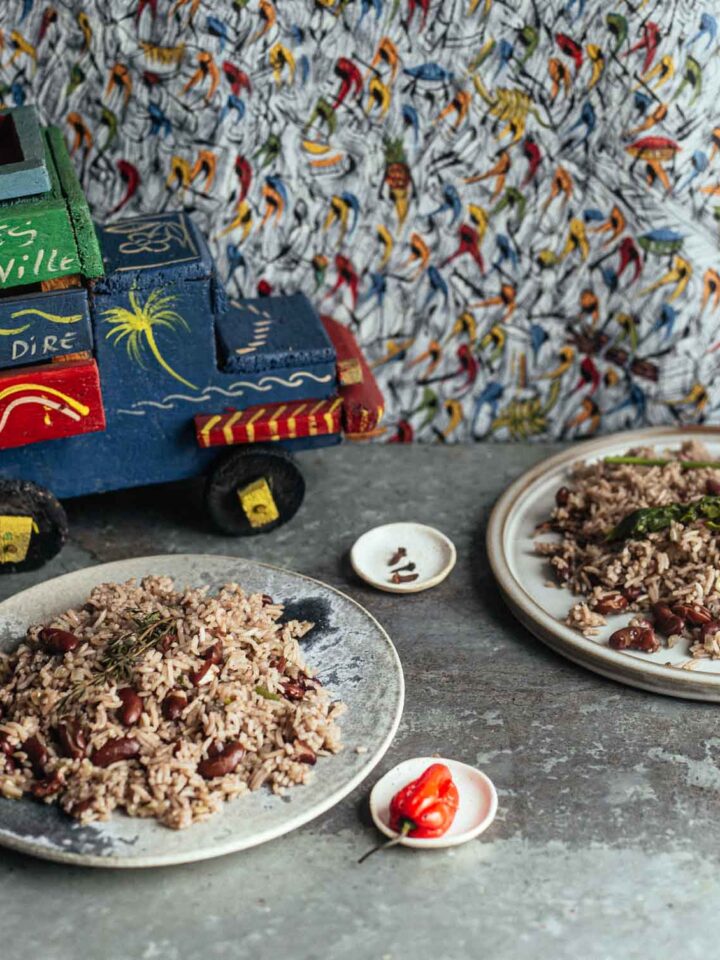
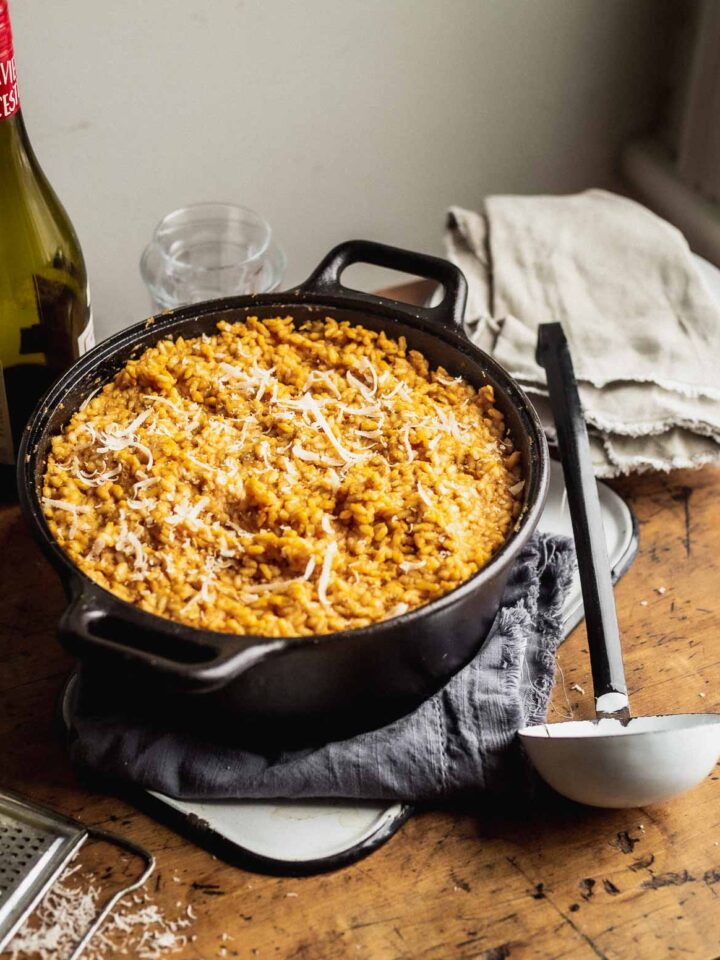
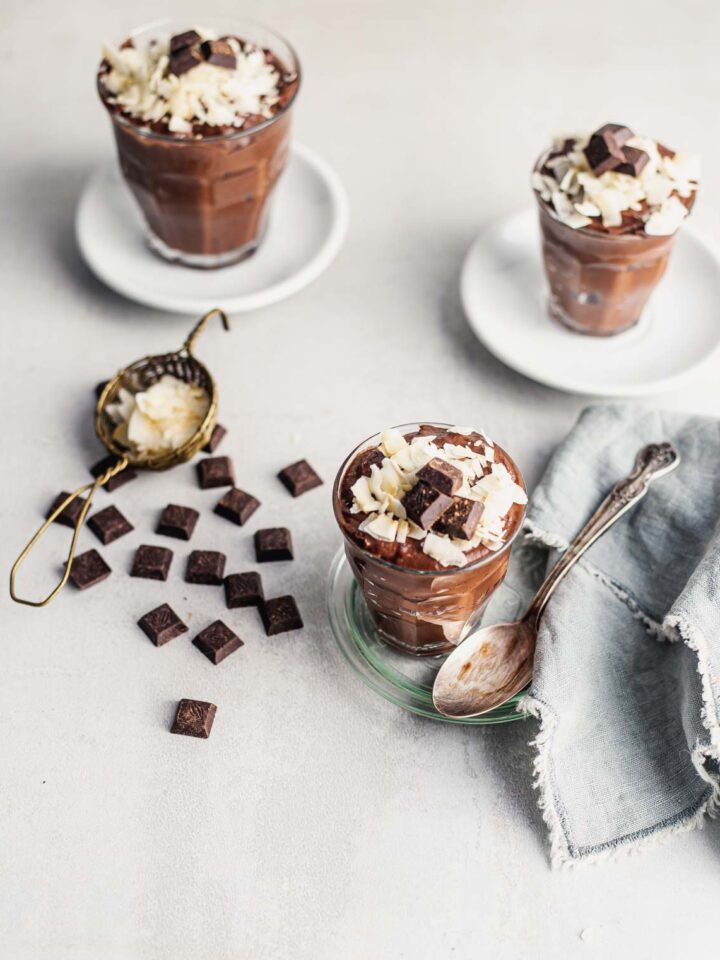
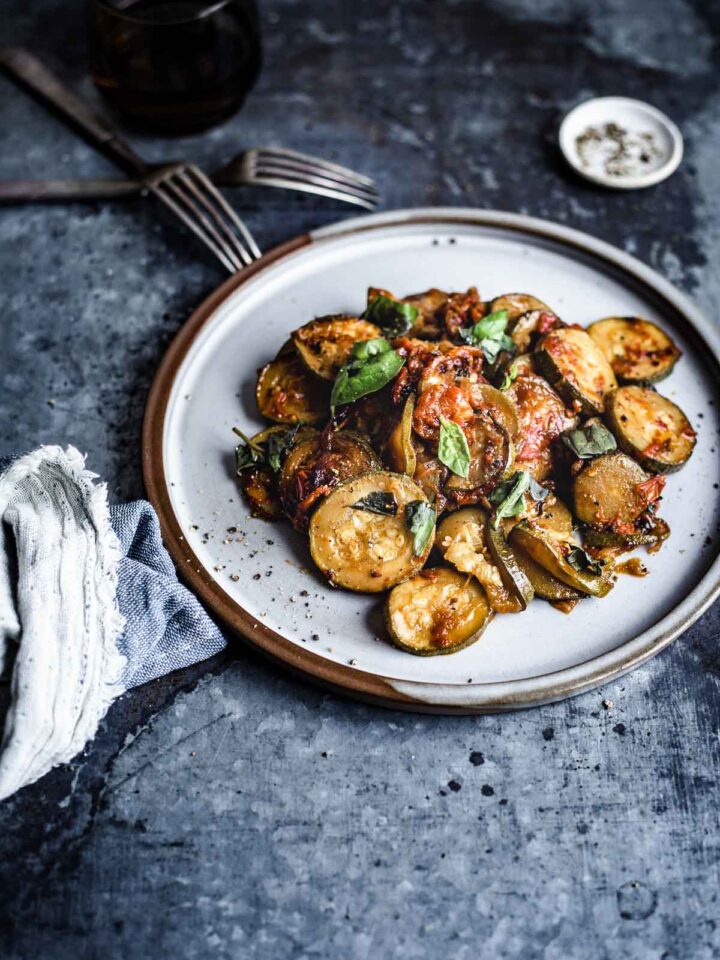
Leave a Reply